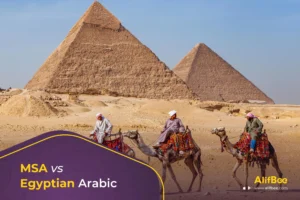History of the Arabic language
Arabic is one of the most important languages around the world. The Arabic language is the mother tongue of around 300 million people and a language that is essential to around two billion Muslims all around the globe.
Today, the term “Arabic language” does not resemble one form of the language. As is the case for other languages, a variety of dialects are used in Arabic-speaking countries.
This can make you, as an Arabic learner or as someone just interested in Arabic, curious, and you may ask yourself, what are the roots of the Arabic language and how did it start? For this reason, we dedicate this article to the history of the Arabic language. Stay with us.
What is the history of the Arab language?
We know that many years and maybe centuries ago, people used to speak the classical Arabic language. Classical Arabic language is the language of the Quran and the language ancient poets used to form many legendary poems.
Nowadays, although we still use classical Arabic, the common dialect used in literature and media is modern standard Arabic. Modern Standard Arabic, or MSA for short, is slightly more straightforward. To understand its present, studying the history of the Arabic language can be helpful.
The Arabic language has been around for hundreds of years, and some speculate that it dates back to the 7th century. According to some linguistics and historians, Arabic is around 1500 years old.
It is believed that the first to speak the Arabic language was the nomadic tribes in the Arabic peninsula. These tribes are thought to have lived south of the Arabic peninsula and moved from there to the north towards the Levant and Iraq and to the southwest towards Ethiopia.
After the immigration of these tribes, their language was affected by the languages of the local languages in the areas they moved to. As a result, we could see differences in how people speak from one country to another.
Those who moved north of the Arabic peninsula preserved many properties of their language due to a lack of contact with others, resulting in what we know as classical Arabic.
When did Arabic become a language?
Arabic is a member of the Semitic language family, along with other languages such as Hebrew and Aramaic. It is unclear when it became a language, but it was at least 1500 years ago.
After the immigration of the nomadic tribes from the south, the language was influenced by other local languages. Therefore, you can see clearly that the Arabic dialects in the levant have a lot of Aramaic and Syriac words and grammar.
In other countries, the influence has been apparent. You can see how the Egyptian and Iraqi Arabic dialects differ with some unique features.
Regarding the writing, it can be hard to tell because Arabic has been used verbally for a long time before the existence of any written Arabic script.
The summary is that it is hard to tell precisely when Arabic became a unique language and when each dialect has been formed. But indeed, it was more than 1500 years ago.
How did Arabic become a national language?
At the beginning of the Islamic state, the official languages used varied from country to country. They used Persian in Iraq, Greek in the Levant and Egypt .. etc. In the 7th century (During the Umayyad state), they began to use Arabic as the official language in all the official papers there.
Arabic becoming the official language of the Islamic state meant that they needed to translate all of the previously written documents, which increased the number of Arabic written scripts. It is said that the translation to Arabic took around 50 years in countries like Iraq.
Being the official language, Arabic is vital because you will need it more. This raised the importance of the Arabic language and made more people want to learn it.
Where did Arabic language originated?
When looking for the original roots of the Arabic language, it appears to have originated from the Arabic peninsula. The first to speak the Arabic language were nomadic tribes living in the southern parts of the Arabic peninsula more than a thousand years ago.
There is a debate about the origin of the Arabic language. Some people believe that the Arabic language is the mother of other languages and that God taught Adam Arabic when He created him. Others believe that the Arabic language was designed to imitate nature’s natural voices and events, such as the peeps of birds and the voice of running water.
While some think classical Arabic is the language of the tribe of Quraysh, others assume it was a blend of many dialects spoken among several other tribes. Thus, the Arabic we know could have originated in the Najd Plateau, which is now Saudi Arabia.
Arabic language roots
When you research the roots of the Arabic language, you will find several different opinions. Some say that Arabic is the mother of all languages and has no roots in other languages. Others say Arabic is derived from and influenced by other languages, such as the Aramaic and Canaanite languages.
History and origin of Arabic language
As we already said, the Arabic language originated in the Arabic peninsula. Tribes used to speak their different versions of Arabic to communicate with each other in various forms, but the Arabic language was used mainly for poetry.
The Arabic culture is famous for its love and admiration for poetry. They used it to express their happiness, sadness, pride, etc. At certain times of the year, they would gather from all over the region in Souk Okaz to say their best poems out loud and compete.
Arabic did not have clear rules and grammar back then because it was rarely used to write scripts and was mainly used for speaking. Locals learned Arabic by practice and felt pride in mastering their language and making glorious poems. Therefore, they have had a lot of competition in poetry.
When the divine revelation was sent to the prophet Mohammad, may peace be upon him, and the Quran was preserved solely in the memory of the first Muslims. The result of this was the presence of the Quran in different dialects.
Later, when Muslims decided to write down the Quran, they had all of these versions written till they decided to use the version written in Quraish dialects. Quraish dialect is what we know now as the classical Quranic dialect. It is the most eloquent dialect among the other Arabic dialects, and it became the measure used to set the grammar of the Arabic language.
With the expansion of the Islamic state, a new problem appeared. The non-Arabic speakers had issues reading the Quran and could not read it as the native Arabic speakers could. This was mainly due to the way the Arabic letters were written down.
Back then, the Arabic scripts used different shapes to represent the alphabet. The letters then had no dots over or under them, meaning that you could not distinguish between similar letters if you were not a native expert Arabic speaker.
For example, we know the letter “taa (ت)” and the letter “baa (ب)” are similar, with only the number of dots and their position as differences. When they were used to be written without dots, you needed to recognize the correct letter from the context.
Another addition to the Arabic language is the use of diacritics. We know now how important it is to use the correct diacritic when pronouncing Arabic words because changing them could mean altering the whole sentence’s meaning and making others understand things you do not mean.
What language family is Arabic?
Languages are the means of communication among people. Language can let you use words instead of signs to tell someone that you miss them, appreciate their help, or want to go to the beach and spend more time with them.
Language can be the reflection of the culture, and it can affect the culture at the same time. If you learn more about a community, you can understand their language better. This can be clear to you in Arabic as you start to learn the language. It can be even more apparent as you dive into the other dialects and talk with people from different Arab countries.
Based on what we said, it would not hit you as a surprise that other languages have landed their effect on the Arabic language just like other languages were affected by it. This influence has been there since the beginning.
First, when talking about the Classical Arabic language, we must say that the Arabic language belongs to the Afro-Asiatic family of languages. Although it may not be the oldest among them, it is one of the few still in use today.
The most significant effect of the Semitic languages on the Arabic language is how Arabic uses the 3 letter roots to form new words. If you are not familiar with the origins, let us explain. In Arabic, you always start with a word of three constant letters and turn them into other words using vowels or diacritics (the equivalent of tiny vowels).
The evolution of the Arabic language
Even though many people may portray the Arabic language as a fixed language that has not changed over the past thousand years, this is not true. Evolution is destined for every language that is still used.
In fact, if we preview the Arabic language as it was at the beginning and compare it to what we have today, we will find that we have two different versions.
When Arabic came up more than a thousand years ago, it was a simple language that used symbols that do not look like today’s alphabet. The new alphabet was influenced by the Aramaic alphabet.
The Arabic language used the Aramaic alphabet and the basics of grammar to build the basis of today’s grammar. The result was in some form of writing that uses connected symbols.
The tribes that used Arabic had pride in their language and used it to communicate with each other and make poems to express what they felt and desired. For a long time, Arabic did not have clear grammar. Arabic people just knew what they needed to say by heart.
After the divine revelation descended to the prophet Mohammad, may peace be upon him, and more non-Arabs converted to Islam, there were a lot of people who felt the need to use the language without knowing the basics.
As a result, and since Arabic was not the primary language of the state, the people started to use a new language that was a mix of the Arabic language and the local languages in the area. This started to distort the Arabic language, and thus, they began setting the rules and grammar. In addition, they used a more sophisticated alphabet (by adding dots and diacritics to the old version of the alphabet) to help everyone read the Arabic text easily.
Levant Arabic
Levant Arabic is a standard Arabic dialect that is widely understood in the Arabic world. As the name suggests, it is used in the levant countries such as Syria, Lebanon, Jordan, and Palestine.
As it is known to many, Levant countries were the home of various nations with different cultures and various languages. As the Islamic state started growing and the Arabic language turned into the official language of the state, there was an increase in the mutual influence between Arabic and the local languages, resulting in what we know today as the Levant Arabic Dialect.
Levant Arabic dialect is an umbrella term describing all the dialects used in the region. Although they change from one country to another and even in the same country, the changes are slight, and you will be able to understand others easily.
The influence comes in different forms, such as:
1. Shortening
Arabic people from other countries have noticed that levant people tend to make their speeches shorter. This comes mainly in the form of making two or three words into one or two.
For example, it is common for them to say things like “mafish” “مَفيش”. It is only one word that means “there is nothing,” “ma fi shii” “ما في شيء”. There are examples of for this like:
- “مَدْرِي” “madri”: It means I do not know “ma Adri” “ما أدري”.
- “لِسَّا” “lissa”: It means “not yet,” and it is short for “lissa3a” “للساعة” and used to talk about something you are waiting for but not yet happened.
- “هَلأ” “halaa”: It means “now,” and it is short for “at this time” “fi haza alwaqt” “في هذا الوقت”.
- “شُوبَاك” or “شبك” “shobak or shibak” is a word that means “what is wrong with you” and is short for “أي شيء هو بك” “ai shaii hoa bika”.
- “بَلاش” “balash”: This word means “free of any charge” and is short for “bila ai shaii” “بلا أي شيء”.
- “شْلُونك” “shlonak”: This is a tricky one; it is short for “sho hoa lonak,” which translates to “What is your color” but it means How are you.
2. Changing the position of the letter
Another common practice used in the levant countries is to alter the position of a specific letter inside the same word. It is usually used to make the word easier to pronounce. The use of these words may be limited to a specific local area and not understood in other places. Some examples of it are in the following:
- “سداجة” instead of “سجادة” (saddaja instead of sajjada) which means carpet
- “جوز” instead of “زوج” (joz instead of zoj) which means husband
- “مجعوز” instead of “مزعوج” (maj3ooz instead of maz3ooj), which means annoyed
3. (Imala) Tilting
This practice was known to be used among some tribes in Najd. Apparently, when some of these tribes moved to the levant, they spread it. This practice aims to turn the sound of the letter “A” in some words into “E.”
This is common among several regions in the levant countries, especially Aleppo in Syria. You can notice its effect on many words to an extent where you may have difficulty understanding what is said to you if you are not familiar with it.
Some examples of that are:
- Kitab becomes kteeb in Aleppo (means book)
- Shareb becomes shereb in Aleppo (means the person who has drunk something)
- Hibal becomes hbeel (which means ropes).
Egyptian Arabic
Egyptian Arabic is a common choice for non-Arabic speakers who want to learn Arabic and move to an Arabic country. Egyptian Arabic is widely understood in the Arabic world mainly due to the popularity of Egyptian cinema and TV series.
If you speak Egyptian, you can communicate with Arabic people from almost every Arabic country and you both are going to know what the other means.
However, Egyptian Arabic itself has seen a huge share of influence by other languages, and the language we have today is the result of progressive change over the years.
One form of this change is the presence of many Coptic words that had been used there till they became a part of the language, such as:
- Terabiza means table “mindada منضدة in standard Arabic.”
- Sahad that means hot “har حر in standard Arabic”
- Kawash a Coptic word used to describe someone who covet and take something.
How did the Arabic language spread?
In recent decades, the importance of the Arabic language has increased significantly, and many people want to learn Arabic. However, the spread of the Arabic language began a long time ago, over one thousand years ago.
We can say that multiple factors helped the Arabic language spread, including:
The Islam
With the expansion of the Islamic state, a lot of people who converted to Islam wanted to learn more about their religion and how to recite the Quran. Since the Quran is only written in Arabic, they had to learn the Arabic language to do so.
Even if the new Muslims did not want to learn how to read the Quran, they would still learn some of the essential Arabic words that are necessary for praying, like Salah “صلاة”, Wudu “وضوء” and Dua “دعاء”.
Being the official language in the state
In the Umayyad era, Arabic became the official language of the Islamic state. That meant that all the new documents that needed to be written were to be written in Arabic, and all of the old documents had to be translated into Arabic.
As a result, all people would need to learn the Arabic language to work and have a job in the Islamic state at that time. Since knowing the Arabic language could give a great advantage, many people choose to learn Arabic.
Trading with other countries
After the Umayyad era, the Islamic empire became quite rich and strong. Since nobody was able to conquer it, trading was more active, and you could find a lot of merchants coming to their territories to buy from them and sell them.
Since the people in the state mainly spoke Arabic, many merchants needed to learn the Arabic language to know how to talk with the Arabic merchants and the other locals, especially since they would need to travel for long periods of time back then.
It became the language of science.
During the golden period of the Islamic era, there was a lot of emphasis on translating the old scripts from other languages to Arabic. After years of translating, and since it became the official language, it has become the language used to gain knowledge.
During that era, Arabic people had a lot of great scientists and researchers who devoted a lot of their time and effort to different fields like math, medicine, chemistry, physics, philosophy, geography, astronomy, and many more.
You can find several libraries in the main cities with various valuable books. There were people whose job was to read the books and make new copies of them to make them available to more students.
Different types of libraries varied in size in both the cities and the countryside. They were present in the rulers’ castles, attached to the schools, and near mosques.
One of the famous libraries was Bayt al-Ḥikmah, which was also known as the Grand Library of Baghdad. This library was built as a private library for the scripts owned by the caliphate to be transformed later into a public library where tens of scientists and translators used to work.
Frequently Asked Questions about Arabic language history
How old is Arabic language?
It is not clear how old the Arabic language is, and the answer is more like speculation because the Arabic language has been used solely verbally for a long time. Some historians estimate that the Arabic language age is around 1500 to 1600 years while others say that Arabic is at least two thousand years old.
Why did Arabic become the common language?
The Arabic language became a common language mainly because it is the language of the Quran, which means that all Muslims need to know some extent of Arabic for their prayers. Another reason is that it was considered the official language of the Islamic empire for a long time, thus it was essential for having important jobs.
How did the Arabic language spread across the world?
Different factors helped spread the Arabic language across the world. The first one is Islam because Arabic is the language of the prayers and the language of the Quran, which is the holy book of Muslims.
With the expansion of the Islamic empire and after Arabic became the language of the state and science, many people felt the need to learn Arabic and knew how important it became.
There was also trading since there were commercial relations between the Islamic state and other nations; Arabic merchants were expected to take their language with them along with their merchandise.
Is Arabic a Semitic language?
Yes, Arabic is one of the Semitic languages. It can be clear that there are some similarities between the Arabic language and Hebrew, which is also another Semitic language. Being a Semitic language means learners with languages derived from Semitic languages can learn Arabic more easily.









